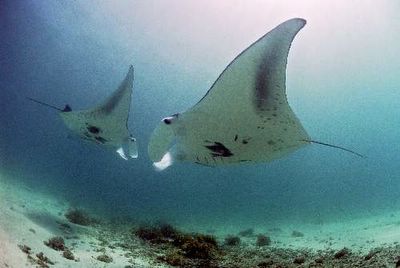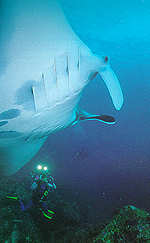manta 1


They feed by filtering plankton and only the bottom of their mouth has teeth. One of the more distictive features of Manta Rays are their cephalic lobes - forward extensions of the cephalic fin - which are used to funnel water to their mouth. In most rays the mouth is on the underside of the body, but in rays it is in the terminal position (a secondary adaptation to plankton feeding).
Manta 2


Color patterns on the underside of the Manta Rays bodie can be used to identify individuals in much the same way tail flukes can be used to identify whales.
Manta 3


Although Manta Rays have tails, they do not have the characteristic spine of the rays. During the course of their evolution the spine has become vestigial - the only thing that remains is a small pit at the base of the tail and a small piece of cartilage under the skin.
manta ray leaping

 Leaping Manta Rays, Daddy Warbucks!
Leaping Manta Rays, Daddy Warbucks!Like whales and some species of shark, Manta Rays leap out of the water. They engage in three different types of leaps: forward landing head first, forward landing tail first and somersaulting. There are three explanations for the leaping: competition for females, cleaning behavior and play. I prefer the last explanation for purley nonscientific reasons. I would like to believe that the ability to engage in playful behavior is a characteristic of, and unites us with, all living things.
An interesting link to some interesting Manta Ray Videos
